Geranium is a genus of 422 hardy flowering plant species.
Contents
Geranium may also refer to:
Geranium is a genus of 422 hardy flowering plant species.
Geranium may also refer to:

Geranium is a genus of 422 species of annual, biennial, and perennial plants that are commonly known as geraniums or cranesbills. They are found throughout the temperate regions of the world and the mountains of the tropics, with the greatest diversity in the eastern part of the Mediterranean region.

Geraniales is a small order of flowering plants, included within the rosid subclade of eudicots. The largest family in the order is Geraniaceae with over 800 species. In addition, the order includes the smaller Francoaceae with about 40 species. Most Geraniales are herbaceous, but there are also shrubs and small trees.
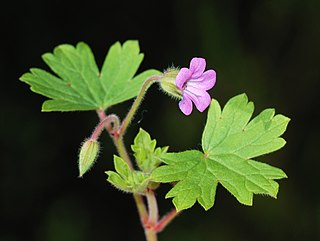
Geraniaceae is a family of flowering plants placed in the order Geraniales. The family name is derived from the genus Geranium. The family includes both the genus Geranium and the garden plants called geraniums, which modern botany classifies as genus Pelargonium, along with other related genera.

Pelargonium is a genus of flowering plants that includes about 280 species of perennials, succulents, and shrubs, commonly called geraniums, pelargoniums, or storksbills. Geranium is also the botanical name and common name of a separate genus of related plants, also known as cranesbills. Both genera belong to the family Geraniaceae, and Carl Linnaeus originally included all the species in one genus, Geranium; they were later separated into two genera by Charles Louis L'Héritier de Brutelle in 1789.

Pelargonium radens, the rasp-leaf pelargonium is a species of Pelargonium. It is in the subgenus Pelargonium along with Pelargonium crispum and Pelargonium tomentosum.
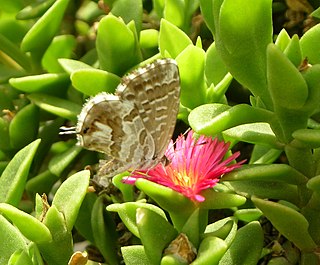
The geranium bronze or brun des pélargoniums in French, is a butterfly in the family Lycaenidae.
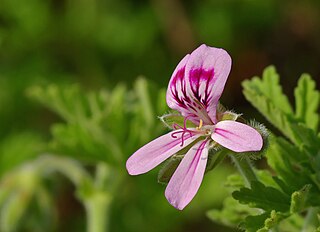
Pelargonium graveolens is a Pelargonium species native to the Cape Provinces and the Northern Provinces of South Africa, Zimbabwe and Mozambique.

Erodium is a genus of flowering plants in the botanical family Geraniaceae. The genus includes about 120 species with a subcosmopolitan distribution, native to Europe, North Africa, Asia, Australia, and more locally in North and South America. They are perennials, annuals, or subshrubs, with five-petalled flowers in shades of white, pink, and purple, that strongly resemble the better-known Geranium (crane's-bills). In English-speaking areas of Europe, the species are known as stork's-bills. In North America they are known as filarees or heron's bill.

Pelargonium peltatum is a scrambling perennial plant with five shallow or deeply lobed, circular- to heart-shaped, somewhat fleshy leaves, sometimes with a differently coloured semicircular band, that has been assigned to the cranesbill family. It carries umbel-like inflorescences with 2–10, white to mauve, bilateral symmetrical flowers, each with a "spur" that is merged with the flower stalk. It is known by several common names including ivy-leaved pelargonium and cascading geranium. It is native to the Cape Provinces of South Africa. In its home range, it flowers year round but most vigorously from August to October.
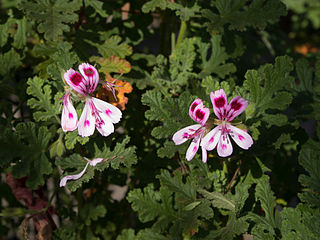
Pelargonium quercifolium is a species of geranium known by the common name oakleaf geranium or oak-geranium. It is native to South Africa, and it is a commonly grown ornamental plant. It is in the subgenus pelargonium along with Pelargonium crispum and Pelargonium tomentosum.

Pelargonium capitatum is one of several species known as rose geranium or rose-scented pelargonium in English. The popular names refer to the scent of the essential oils extracted from glandular tissue, not the flowers, which have hardly any scent to speak of. Some of the species are known as kusmalva in Afrikaans.
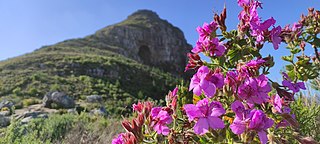
Pelargonium cucullatum is a hairy, upright, branching, perennial shrub, of 1–2 m (3.3–6.6 ft) high, that has been assigned to the cranesbill family. It sprouts new stems from the underground rootstock and becomes woody at its base. It has alternately set, sometimes slightly succulent leaves crowded near the top of the branches, with leaf stalks and flat to hood-shaped leaf blades, with a rounded broad triangular to kidney-shaped outline of about 4–5.5 cm long and 5–9 cm wide, often somewhat incised, the margin with irregular teeth. The white to purplish red, 5-merous, somewhat mirror symmetrical flowers grow in umbel-like clusters, and each contain mostly 7 fertile stamens and 3 infertile staminodes of different length. P. cucullatum has been cultivated as a garden ornamental and house plant since the 17th century. It has been used to breed many modern pelargonium hybrids, notably the Regal pelargoniums. It is called hooded-leaf pelargonium or herba althaea in English and wildemalva in Afrikaans.

Pelargonium × hortorum, commonly called zonal geranium, or garden geranium, is a nothospecies of Pelargonium most commonly used as an ornamental plant. It is a hybrid between Pelargonium zonale and Pelargonium inquinans. They are the group of Pelargonium cultivars, with leaves marked with a brown annular zone and inflorescence in the form of large balls of tight flowers, usually red, pink, or white. These are the most common geraniums of garden centers and florists, sold in pots for windowsills and balconies or planted in flowerbeds.
Musk, also known as musk oil, is a class of aromatic substances commonly used as base notes in perfumery.

Pelargonium zonale is a species of Pelargonium native to southern Africa in the western regions of the Cape Provinces, in the geranium family. It is one of the parents of the widely cultivated plant Pelargonium × hortorum, often called "geranium", "horseshoe geranium", "zonal geranium" or "zonal pelargonium".

Pelargonium inquinans, the scarlet geranium, is a species of plant in the genus Pelargonium. It is a shrub endemic to South Africa, ranging from Mpumalanga to KwaZulu-Natal and Eastern Cape provinces. It is one of the ancestors of the hybrid line of horticultural pelargoniums, referred to as the zonal group. They can easily be propagated by seeds and cuttings.
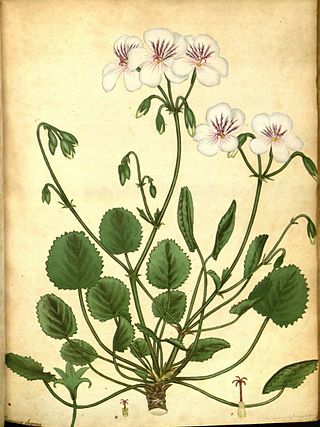
Pelargonium elegans is a species of flowering plants in the family Geraniaceae.

Pelargonium luridum, locally called variable stork's bill, is a medium high, tuberous herbaceous perennial geophyte, belonging to the Stork's bill family, with white to pink, slightly mirror symmetrical flowers in umbels on long unbranched stalks directly from the ground rosette that consists of few initially ovate, later pinnately incised or linear leaves, with blunt teeth around the margin. The variable stork's bill naturally occurs from South Africa to Angola, southern Congo and Tanzania.
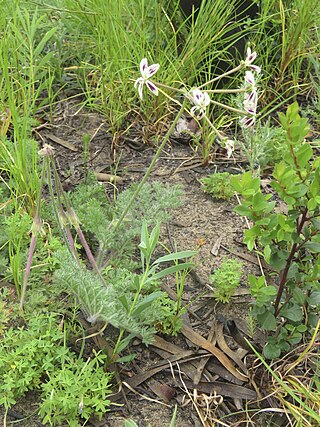
Pelargonium triste, is a geophyte with flowering stems of about 25 cm (9.8 in) high on average, that is assigned to the Stork's bill family. It has hairy, divided and softly feathered leaves that are about twice as long as wide, resemble carrot leaves, and emerge from the tuberous rootstock directly at ground level. The bracts on the flowering stems are usually much smaller than the leaves at ground level. It carries inconspicuous, star-shaped flowers, each with a "spur" that is merged with the flower stalk, with five free green sepals, 5 pale yellow petals, 10 filaments, only 7 of them initially carrying an anther and a style with 5 curved branches. The flowers are crowded in umbels, and mostly there are slight to intense maroon to black markings that may be small or cover the entire petal except for a narrow line along the margins. In the evening, the flowers start to smell like cloves. Flowers may be found practically year round, but most proficiently from September to December. As typical for many species in the Stork's bill family, its fruits resemble the neck, head and bill of a stork. It is known as the night-scented pelargonium in English, kaneeltjie, pypkaneel or rooiwortel in Afrikaans and wit n/eitjie in the Khoi language.